2003 CHEVROLET TRAIL BLAZER seats
[x] Cancel search: seatsPage 1 of 436

Seats and Restraint Systems........................... 1-1
Front Seats
............................................... 1-2
Rear Seats
............................................... 1-6
Safety Belts
.............................................. 1-8
Child Restraints
.......................................1-28
Air Bag Systems
......................................1-49
Restraint System Check
............................1-59
Features and Controls..................................... 2-1
Keys
........................................................ 2-3
Doors and Locks
....................................... 2-8
Windows
.................................................2-14
Theft-Deterrent Systems
............................2-16
Starting and Operating Your Vehicle
...........2-18
Mirrors
....................................................2-34
OnStar
žSystem
......................................2-38
HomeLinkžTransmitter
.............................2-39
Storage Areas
.........................................2-43
Sunroof
..................................................2-50
Vehicle Personalization
.............................2-50
Instrument Panel............................................. 3-1
Instrument Panel Overview
.......................... 3-4
Climate Controls
......................................3-21
Warning Lights, Gages and Indicators
.........3-35
Driver Information Center (DIC)
..................3-51Audio System(s)
.......................................3-64
Driving Your Vehicle....................................... 4-1
Your Driving, the Road, and Your Vehicle
..... 4-2
Towing
...................................................4-44
Service and Appearance Care.......................... 5-1
Service
..................................................... 5-3
Fuel
......................................................... 5-4
Checking Things Under the Hood
...............5-10
Rear Axle
...............................................5-47
Four-Wheel Drive
.....................................5-48
Bulb Replacement
....................................5-50
Windshield Wiper Blade Replacement
.........5-51
Tires
......................................................5-54
Appearance Care
.....................................5-79
Vehicle Identi®cation
.................................5-87
Electrical System
......................................5-88
Capacities and Speci®cations
...................5-100
Normal Maintenance Replacement Parts
....5-102
Maintenance Schedule..................................... 6-1
Maintenance Schedule
................................ 6-2
Customer Assistance Information.................... 7-1
Customer Assistance Information
.................. 7-2
Reporting Safety Defects
............................ 7-8
Index................................................................ 1
2003 Chevrolet TrailBlazerM
Page 4 of 436
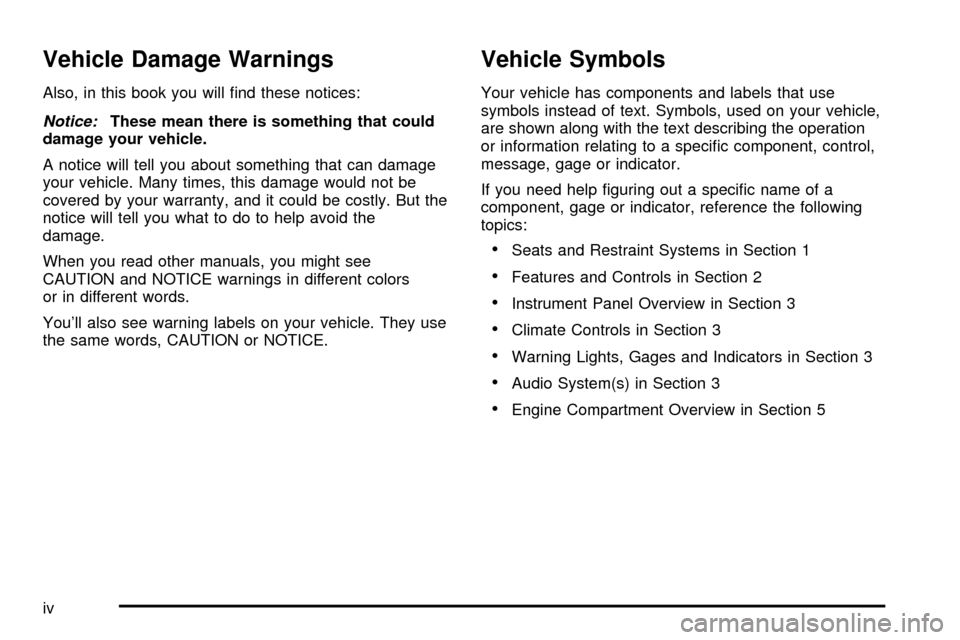
Vehicle Damage Warnings
Also, in this book you will ®nd these notices:
Notice:These mean there is something that could
damage your vehicle.
A notice will tell you about something that can damage
your vehicle. Many times, this damage would not be
covered by your warranty, and it could be costly. But the
notice will tell you what to do to help avoid the
damage.
When you read other manuals, you might see
CAUTION and NOTICE warnings in different colors
or in different words.
You'll also see warning labels on your vehicle. They use
the same words, CAUTION or NOTICE.
Vehicle Symbols
Your vehicle has components and labels that use
symbols instead of text. Symbols, used on your vehicle,
are shown along with the text describing the operation
or information relating to a speci®c component, control,
message, gage or indicator.
If you need help ®guring out a speci®c name of a
component, gage or indicator, reference the following
topics:
·Seats and Restraint Systems in Section 1
·Features and Controls in Section 2
·Instrument Panel Overview in Section 3
·Climate Controls in Section 3
·Warning Lights, Gages and Indicators in Section 3
·Audio System(s) in Section 3
·Engine Compartment Overview in Section 5
iv
Page 7 of 436
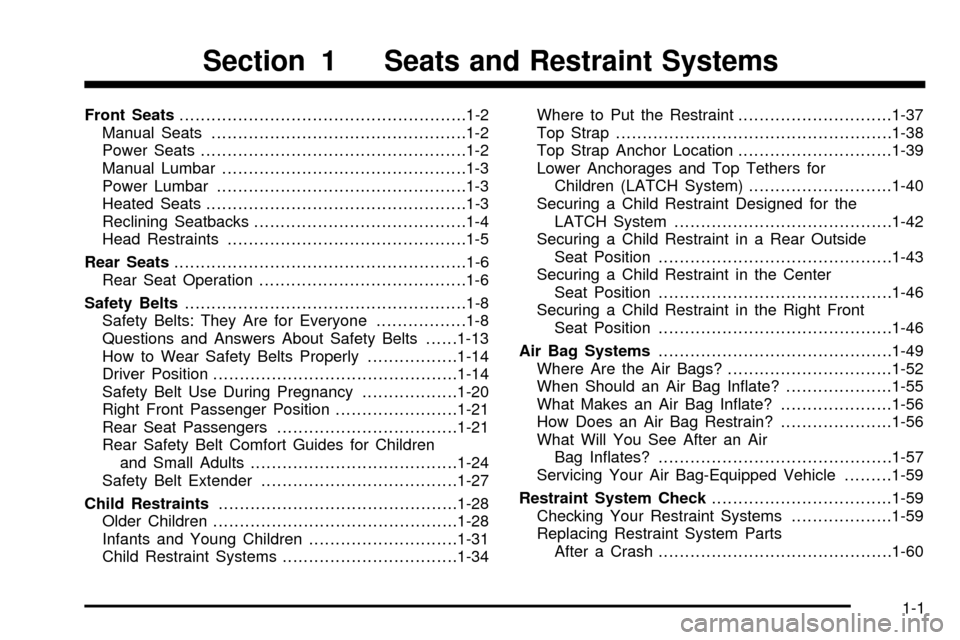
Front Seats......................................................1-2
Manual Seats................................................1-2
Power Seats..................................................1-2
Manual Lumbar..............................................1-3
Power Lumbar...............................................1-3
Heated Seats.................................................1-3
Reclining Seatbacks........................................1-4
Head Restraints.............................................1-5
Rear Seats.......................................................1-6
Rear Seat Operation.......................................1-6
Safety Belts.....................................................1-8
Safety Belts: They Are for Everyone.................1-8
Questions and Answers About Safety Belts......1-13
How to Wear Safety Belts Properly.................1-14
Driver Position..............................................1-14
Safety Belt Use During Pregnancy..................1-20
Right Front Passenger Position.......................1-21
Rear Seat Passengers..................................1-21
Rear Safety Belt Comfort Guides for Children
and Small Adults.......................................1-24
Safety Belt Extender.....................................1-27
Child Restraints.............................................1-28
Older Children..............................................1-28
Infants and Young Children............................1-31
Child Restraint Systems.................................1-34Where to Put the Restraint.............................1-37
Top Strap....................................................1-38
Top Strap Anchor Location.............................1-39
Lower Anchorages and Top Tethers for
Children (LATCH System)...........................1-40
Securing a Child Restraint Designed for the
LATCH System.........................................1-42
Securing a Child Restraint in a Rear Outside
Seat Position............................................1-43
Securing a Child Restraint in the Center
Seat Position............................................1-46
Securing a Child Restraint in the Right Front
Seat Position............................................1-46
Air Bag Systems............................................1-49
Where Are the Air Bags?...............................1-52
When Should an Air Bag In¯ate?....................1-55
What Makes an Air Bag In¯ate?.....................1-56
How Does an Air Bag Restrain?.....................1-56
What Will You See After an Air
Bag In¯ates?............................................1-57
Servicing Your Air Bag-Equipped Vehicle.........1-59
Restraint System Check..................................1-59
Checking Your Restraint Systems...................1-59
Replacing Restraint System Parts
After a Crash............................................1-60
Section 1 Seats and Restraint Systems
1-1
Page 8 of 436
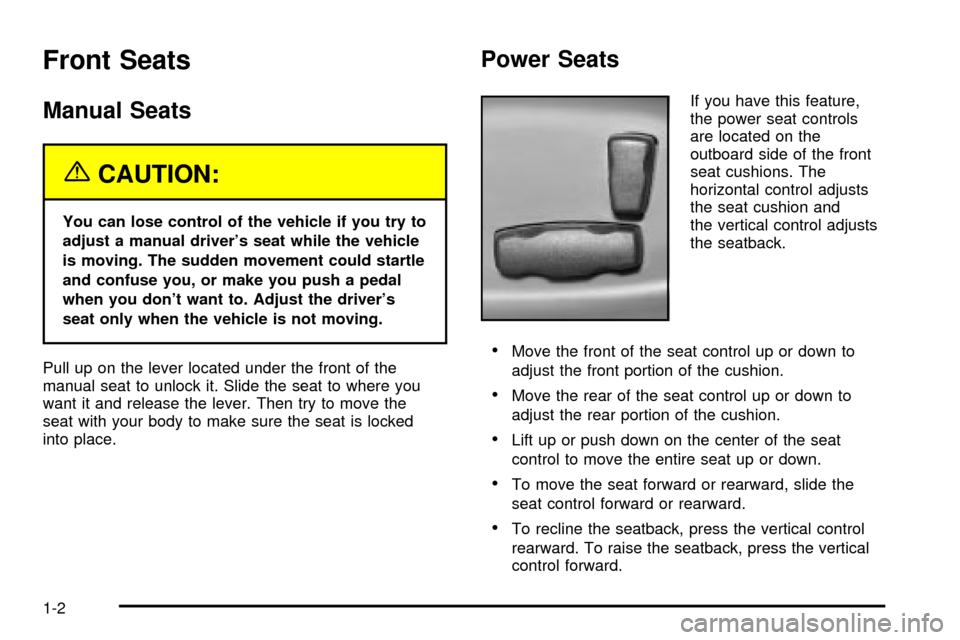
Front Seats
Manual Seats
{CAUTION:
You can lose control of the vehicle if you try to
adjust a manual driver's seat while the vehicle
is moving. The sudden movement could startle
and confuse you, or make you push a pedal
when you don't want to. Adjust the driver's
seat only when the vehicle is not moving.
Pull up on the lever located under the front of the
manual seat to unlock it. Slide the seat to where you
want it and release the lever. Then try to move the
seat with your body to make sure the seat is locked
into place.
Power Seats
If you have this feature,
the power seat controls
are located on the
outboard side of the front
seat cushions. The
horizontal control adjusts
the seat cushion and
the vertical control adjusts
the seatback.
·Move the front of the seat control up or down to
adjust the front portion of the cushion.
·Move the rear of the seat control up or down to
adjust the rear portion of the cushion.
·Lift up or push down on the center of the seat
control to move the entire seat up or down.
·To move the seat forward or rearward, slide the
seat control forward or rearward.
·To recline the seatback, press the vertical control
rearward. To raise the seatback, press the vertical
control forward.
1-2
Page 9 of 436
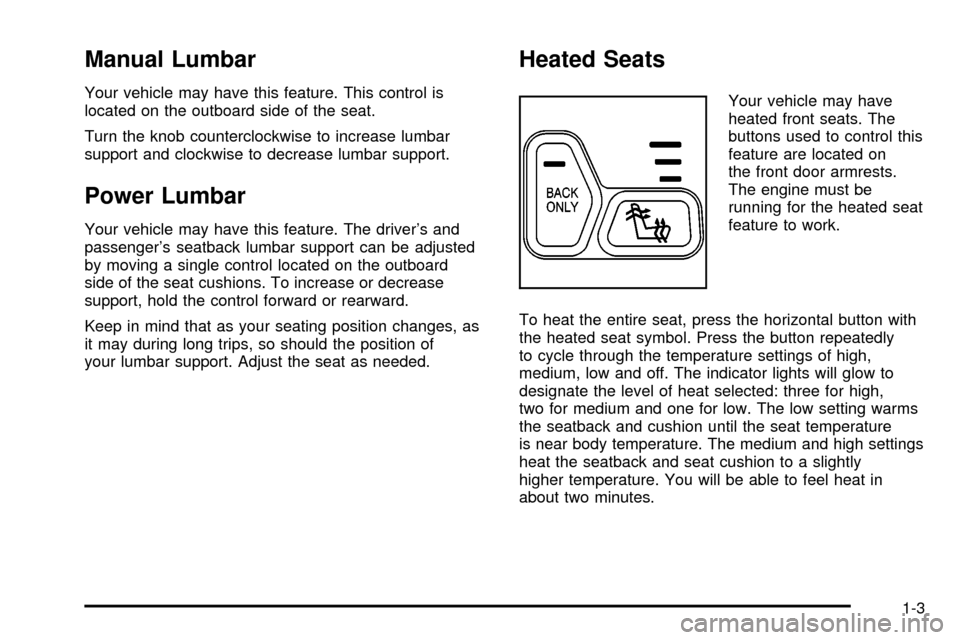
Manual Lumbar
Your vehicle may have this feature. This control is
located on the outboard side of the seat.
Turn the knob counterclockwise to increase lumbar
support and clockwise to decrease lumbar support.
Power Lumbar
Your vehicle may have this feature. The driver's and
passenger's seatback lumbar support can be adjusted
by moving a single control located on the outboard
side of the seat cushions. To increase or decrease
support, hold the control forward or rearward.
Keep in mind that as your seating position changes, as
it may during long trips, so should the position of
your lumbar support. Adjust the seat as needed.
Heated Seats
Your vehicle may have
heated front seats. The
buttons used to control this
feature are located on
the front door armrests.
The engine must be
running for the heated seat
feature to work.
To heat the entire seat, press the horizontal button with
the heated seat symbol. Press the button repeatedly
to cycle through the temperature settings of high,
medium, low and off. The indicator lights will glow to
designate the level of heat selected: three for high,
two for medium and one for low. The low setting warms
the seatback and cushion until the seat temperature
is near body temperature. The medium and high settings
heat the seatback and seat cushion to a slightly
higher temperature. You will be able to feel heat in
about two minutes.
1-3
Page 12 of 436
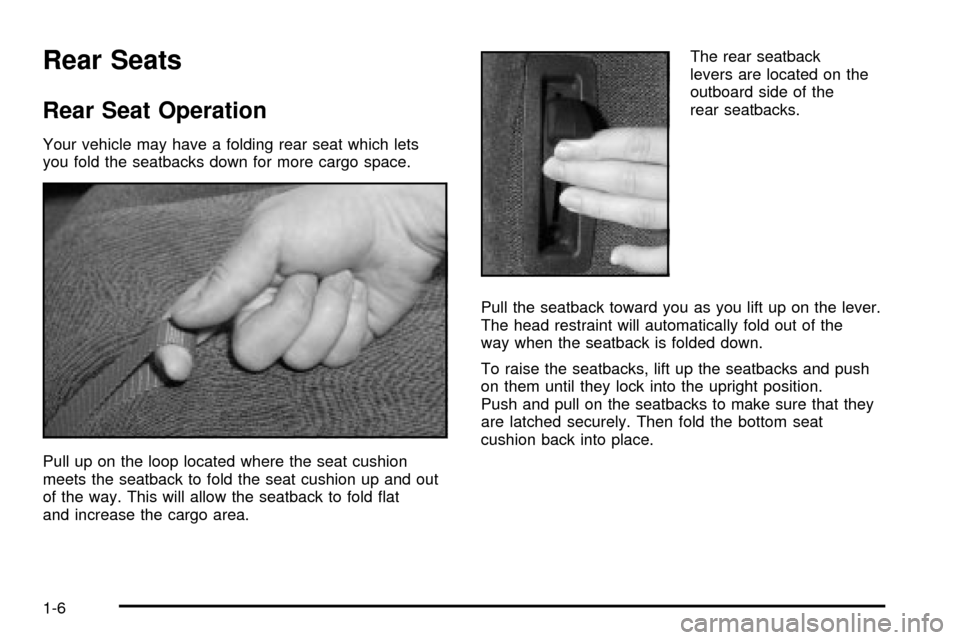
Rear Seats
Rear Seat Operation
Your vehicle may have a folding rear seat which lets
you fold the seatbacks down for more cargo space.
Pull up on the loop located where the seat cushion
meets the seatback to fold the seat cushion up and out
of the way. This will allow the seatback to fold ¯at
and increase the cargo area.The rear seatback
levers are located on the
outboard side of the
rear seatbacks.
Pull the seatback toward you as you lift up on the lever.
The head restraint will automatically fold out of the
way when the seatback is folded down.
To raise the seatbacks, lift up the seatbacks and push
on them until they lock into the upright position.
Push and pull on the seatbacks to make sure that they
are latched securely. Then fold the bottom seat
cushion back into place.
1-6
Page 13 of 436
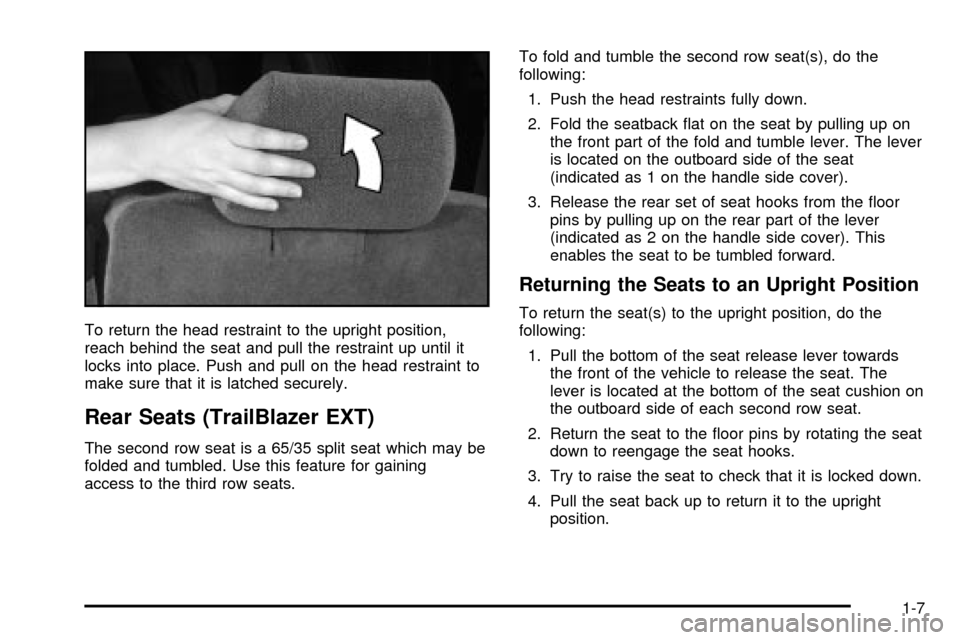
To return the head restraint to the upright position,
reach behind the seat and pull the restraint up until it
locks into place. Push and pull on the head restraint to
make sure that it is latched securely.
Rear Seats (TrailBlazer EXT)
The second row seat is a 65/35 split seat which may be
folded and tumbled. Use this feature for gaining
access to the third row seats.To fold and tumble the second row seat(s), do the
following:
1. Push the head restraints fully down.
2. Fold the seatback ¯at on the seat by pulling up on
the front part of the fold and tumble lever. The lever
is located on the outboard side of the seat
(indicated as 1 on the handle side cover).
3. Release the rear set of seat hooks from the ¯oor
pins by pulling up on the rear part of the lever
(indicated as 2 on the handle side cover). This
enables the seat to be tumbled forward.
Returning the Seats to an Upright Position
To return the seat(s) to the upright position, do the
following:
1. Pull the bottom of the seat release lever towards
the front of the vehicle to release the seat. The
lever is located at the bottom of the seat cushion on
the outboard side of each second row seat.
2. Return the seat to the ¯oor pins by rotating the seat
down to reengage the seat hooks.
3. Try to raise the seat to check that it is locked down.
4. Pull the seat back up to return it to the upright
position.
1-7
Page 14 of 436
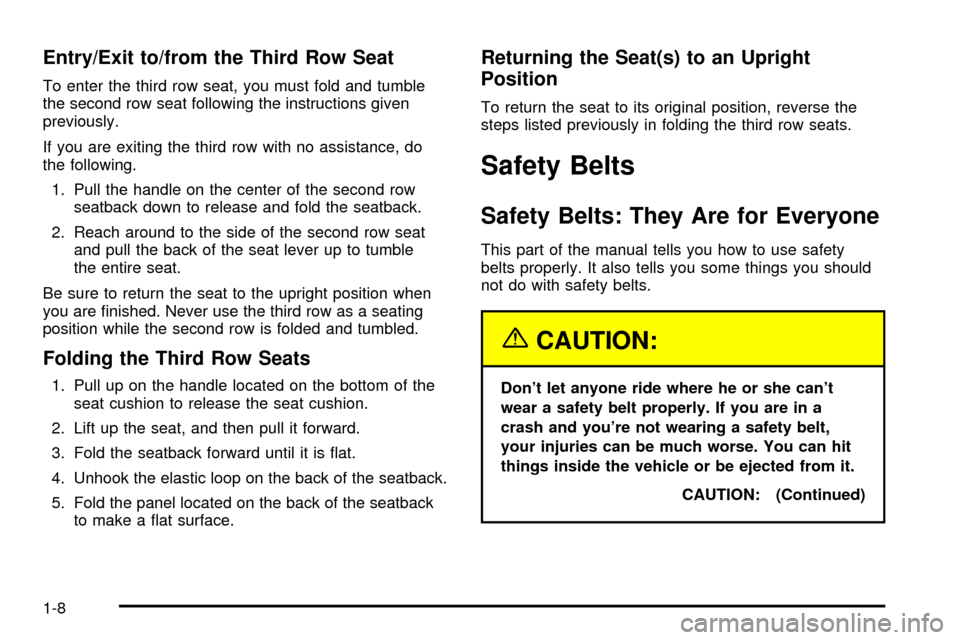
Entry/Exit to/from the Third Row Seat
To enter the third row seat, you must fold and tumble
the second row seat following the instructions given
previously.
If you are exiting the third row with no assistance, do
the following.
1. Pull the handle on the center of the second row
seatback down to release and fold the seatback.
2. Reach around to the side of the second row seat
and pull the back of the seat lever up to tumble
the entire seat.
Be sure to return the seat to the upright position when
you are ®nished. Never use the third row as a seating
position while the second row is folded and tumbled.
Folding the Third Row Seats
1. Pull up on the handle located on the bottom of the
seat cushion to release the seat cushion.
2. Lift up the seat, and then pull it forward.
3. Fold the seatback forward until it is ¯at.
4. Unhook the elastic loop on the back of the seatback.
5. Fold the panel located on the back of the seatback
to make a ¯at surface.
Returning the Seat(s) to an Upright
Position
To return the seat to its original position, reverse the
steps listed previously in folding the third row seats.
Safety Belts
Safety Belts: They Are for Everyone
This part of the manual tells you how to use safety
belts properly. It also tells you some things you should
not do with safety belts.
{CAUTION:
Don't let anyone ride where he or she can't
wear a safety belt properly. If you are in a
crash and you're not wearing a safety belt,
your injuries can be much worse. You can hit
things inside the vehicle or be ejected from it.
CAUTION: (Continued)
1-8